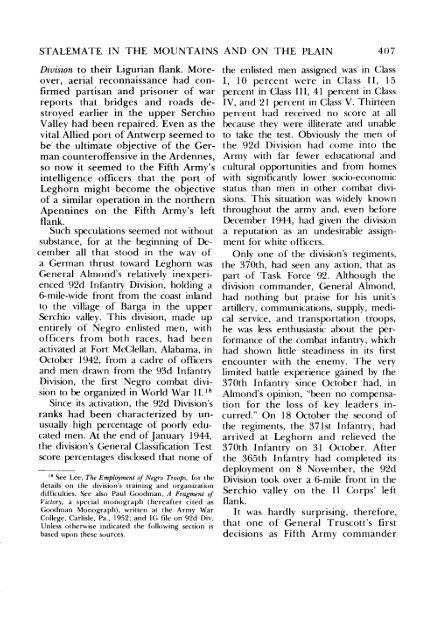Cassino to the Alps - US Army Center Of Military History
Cassino to the Alps - US Army Center Of Military History
Cassino to the Alps - US Army Center Of Military History
Create successful ePaper yourself
Turn your PDF publications into a flip-book with our unique Google optimized e-Paper software.
STALEMATE IN THE MOUNTAINS AND ON THE PLAIN 407<br />
Division <strong>to</strong> <strong>the</strong>ir Ligurian flank. Moreover,<br />
aerial reconnaissance had confirmed<br />
partisan and prisoner of war<br />
reports that bridges and roads destroyed<br />
earlier in <strong>the</strong> upper Serchio<br />
Valley had been repaired. Even as <strong>the</strong><br />
vital Allied port of Antwerp seemed <strong>to</strong><br />
be <strong>the</strong> ultimate objective of <strong>the</strong> German<br />
counteroffensive in <strong>the</strong> Ardennes,<br />
so now it seemed <strong>to</strong> <strong>the</strong> Fifth <strong>Army</strong>'s<br />
intelligence officers that <strong>the</strong> port of<br />
Leghorn might become <strong>the</strong> objective<br />
of a similar operation in <strong>the</strong> nor<strong>the</strong>rn<br />
Apennines on <strong>the</strong> Fifth <strong>Army</strong>'s left<br />
flank.<br />
Such speculations seemed not without<br />
substance, for at <strong>the</strong> beginning of December<br />
all that s<strong>to</strong>od in <strong>the</strong> way of<br />
a German thrust <strong>to</strong>ward Leghorn was<br />
General Almond's relatively inexperienced<br />
92d Infantry Division, holding a<br />
6-mile-wide front from <strong>the</strong> coast inland<br />
<strong>to</strong> <strong>the</strong> village of Barga in <strong>the</strong> upper<br />
Serchio valley. This division, made up<br />
entirely of Negro enlisted men, with<br />
officers from both races, had been<br />
activated at Fort McClellan, Alabama, in<br />
Oc<strong>to</strong>ber 1942, from a cadre of officers<br />
and men drawn from <strong>the</strong> 93d Infantry<br />
Division, <strong>the</strong> first Negro combat division<br />
<strong>to</strong> be organized in World War 11. 18<br />
Since its activation, <strong>the</strong> 92d Division's<br />
ranks had been characterized by unusually<br />
high percentage of poorly educated<br />
men. At <strong>the</strong> end of January 1944,<br />
<strong>the</strong> division's General Classification Test<br />
score percentages disclosed that none of<br />
18 See Lee, The Employment of Negro Troops, for <strong>the</strong><br />
details on <strong>the</strong> division's training and organization<br />
difficulties. See also Paul Goodman, A Fragment of<br />
Vic<strong>to</strong>ry, a special monograph (hereafter cited as<br />
Goodman Monograph), written at <strong>the</strong> <strong>Army</strong> War<br />
College, Carlisle, Pa., 1952; and IG file on 92d Div.<br />
Unless o<strong>the</strong>rwise indicated <strong>the</strong> following section is<br />
based upon <strong>the</strong>se sources.<br />
<strong>the</strong> enlisted men assigned was in Class<br />
I, 10 percent were in Class II, IS<br />
percent in Class III, 41 percent in Class<br />
IV, and 21 percent in Class V. Thirteen<br />
percent had received no score at all<br />
because <strong>the</strong>y were illiterate and unable<br />
<strong>to</strong> take <strong>the</strong> test. Obviously <strong>the</strong> men of<br />
<strong>the</strong> 92d Division had come in<strong>to</strong> <strong>the</strong><br />
<strong>Army</strong> with far fewer educational and<br />
cultural opportunities and from homes<br />
with significantly lower socio-economic<br />
status than men in o<strong>the</strong>r combat divisions.<br />
This situation was widely known<br />
throughout <strong>the</strong> army and, even before<br />
December 1944, had given <strong>the</strong> division<br />
a reputation as an undesirable assignment<br />
for white officers.<br />
Only one of <strong>the</strong> division's regiments,<br />
<strong>the</strong> 370th, had seen any action, that as<br />
part of Task Force 92. Although <strong>the</strong><br />
division commander, General Almond,<br />
had nothing but praise for his unit's<br />
artillery, communications, supply, medical<br />
service, and transportation troops,<br />
he was less enthusiastic about <strong>the</strong> performance<br />
of <strong>the</strong> combat infantry, which<br />
had shown little steadiness in its first<br />
encounter with <strong>the</strong> enemy. The very<br />
limited battle experience gained by <strong>the</strong><br />
370th Infantry since Oc<strong>to</strong>ber had, in<br />
Almond's opinion, "been no compensation<br />
for <strong>the</strong> loss of key leaders incurred."<br />
On 18 Oc<strong>to</strong>ber <strong>the</strong> second of<br />
<strong>the</strong> regiments, <strong>the</strong> 371 st Infantry, had<br />
arrived at Leghorn and relieved <strong>the</strong><br />
370th Infantry on 31 Oc<strong>to</strong>ber. After<br />
<strong>the</strong> 36Sth Infantry had completed its<br />
deployment on 8 November, <strong>the</strong> 92d<br />
Division <strong>to</strong>ok over a 6-mile front in <strong>the</strong><br />
Serchi6 valley on <strong>the</strong> I I Corps' left<br />
flank.<br />
I t was hardly surprising, <strong>the</strong>refore,<br />
that one of General Truscott's first<br />
decisions as Fifth <strong>Army</strong> commander
















